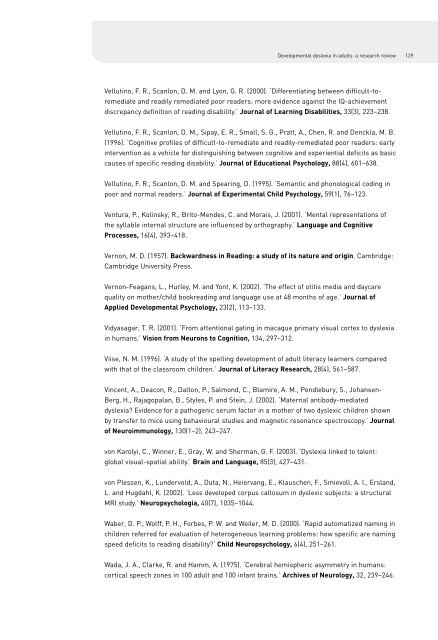01 NRDC Dyslexia 1-88 update - Texthelp
01 NRDC Dyslexia 1-88 update - Texthelp
01 NRDC Dyslexia 1-88 update - Texthelp
Create successful ePaper yourself
Turn your PDF publications into a flip-book with our unique Google optimized e-Paper software.
Developmental dyslexia in adults: a research review 129<br />
Vellutino, F. R., Scanlon, D. M. and Lyon, G. R. (2000). ‘Differentiating between difficult-toremediate<br />
and readily remediated poor readers: more evidence against the IQ-achievement<br />
discrepancy definition of reading disability.’ Journal of Learning Disabilities, 33(3), 223–238.<br />
Vellutino, F. R., Scanlon, D. M., Sipay, E. R., Small, S. G., Pratt, A., Chen, R. and Denckla, M. B.<br />
(1996). ‘Cognitive profiles of difficult-to-remediate and readily-remediated poor readers: early<br />
intervention as a vehicle for distinguishing between cognitive and experiential deficits as basic<br />
causes of specific reading disability.’ Journal of Educational Psychology, <strong>88</strong>(4), 6<strong>01</strong>–638.<br />
Vellutino, F. R., Scanlon, D. M. and Spearing, D. (1995). ‘Semantic and phonological coding in<br />
poor and normal readers.’ Journal of Experimental Child Psychology, 59(1), 76–123.<br />
Ventura, P., Kolinsky, R., Brito-Mendes, C. and Morais, J. (20<strong>01</strong>). ‘Mental representations of<br />
the syllable internal structure are influenced by orthography.’ Language and Cognitive<br />
Processes, 16(4), 393–418.<br />
Vernon, M. D. (1957). Backwardness in Reading: a study of its nature and origin. Cambridge:<br />
Cambridge University Press.<br />
Vernon-Feagans, L., Hurley, M. and Yont, K. (2002). ‘The effect of otitis media and daycare<br />
quality on mother/child bookreading and language use at 48 months of age.’ Journal of<br />
Applied Developmental Psychology, 23(2), 113–133.<br />
Vidyasagar, T. R. (20<strong>01</strong>). ‘From attentional gating in macaque primary visual cortex to dyslexia<br />
in humans.’ Vision from Neurons to Cognition, 134, 297–312.<br />
Viise, N. M. (1996). ‘A study of the spelling development of adult literacy learners compared<br />
with that of the classroom children.’ Journal of Literacy Research, 28(4), 561–587.<br />
Vincent, A., Deacon, R., Dalton, P., Salmond, C., Blamire, A. M., Pendlebury, S., Johansen-<br />
Berg, H., Rajagopalan, B., Styles, P. and Stein, J. (2002). ‘Maternal antibody-mediated<br />
dyslexia? Evidence for a pathogenic serum factor in a mother of two dyslexic children shown<br />
by transfer to mice using behavioural studies and magnetic resonance spectroscopy.’ Journal<br />
of Neuroimmunology, 130(1–2), 243–247.<br />
von Karolyi, C., Winner, E., Gray, W. and Sherman, G. F. (2003). ‘<strong>Dyslexia</strong> linked to talent:<br />
global visual-spatial ability.’ Brain and Language, 85(3), 427–431.<br />
von Plessen, K., Lundervold, A., Duta, N., Heiervang, E., Klauschen, F., Smievoll, A. I., Ersland,<br />
L. and Hugdahl, K. (2002). ‘Less developed corpus callosum in dyslexic subjects: a structural<br />
MRI study.’ Neuropsychologia, 40(7), 1035–1044.<br />
Waber, D. P., Wolff, P. H., Forbes, P. W. and Weiler, M. D. (2000). ‘Rapid automatized naming in<br />
children referred for evaluation of heterogeneous learning problems: how specific are naming<br />
speed deficits to reading disability?’ Child Neuropsychology, 6(4), 251–261.<br />
Wada, J. A., Clarke, R. and Hamm, A. (1975). ‘Cerebral hemispheric asymmetry in humans:<br />
cortical speech zones in 100 adult and 100 infant brains.’ Archives of Neurology, 32, 239–246.
















